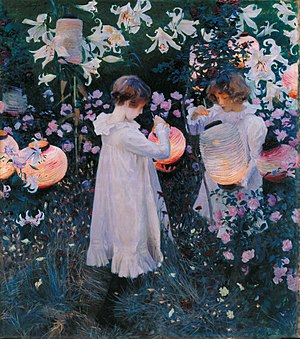Carnation, lily, lily, rose

|
| Carnation, lily, lily, rose |
|---|
| John Singer Sargent , 1885–86 |
| Oil on canvas |
| 174.0 x 153.7 cm |
| Tate Britain, London |
Carnation, Lily, Lily, Rose (in the English original Carnation, Lily, Lily, Rose ) is a painting by John Singer Sargent , which was created in oil on canvas in the years 1885–86 . It was purchased in 1887 with funds from the Francis Leggatt Chantrey Foundation and exhibited there after the Tate Gallery was built in 1897.
Image description
In the twilight of a summer evening, two girls in simple white dresses are busy lighting lanterns in a garden, probably with the help of wax sticks ; their faces are lit by the warm light of the candles. From the long grass at their feet, dark red and white carnations rise up everywhere , above them in the background and also in the lower right in the foreground rose- pink blooming rose bushes can be seen. White lilies rise above the girls' heads on long stalks . A cord is stretched between the rose bushes and a stick that has been rammed into the ground, on which, in addition to the lanterns that the girls light, hang other, partly already lit, paper lanterns.
Emergence
As early as 1884 Sargent had made a garden study of the Vickers children , which also shows two children and almost larger than life-sized lilies. However, the idea for Carnation, Lily, Lily, Rose came to him “on a boat trip [...] on the Thames near Pangbourne in September 1885 with the American artist Edwin Austin Abbey , during which he saw Chinese lanterns hanging between trees and lilies. "
Sargent made a large number of studies on the posture of people and flowers. As a model he first used Katherine, the then five-year-old daughter of his painter colleague Francis Davis Millet , but soon afterwards Dorothy "Dolly" and Polly Barnard, the daughters of the illustrator Frederick Barnard . Eleven-year-old Dolly can be seen on the left side of the picture, then seven-year-old Polly on the right; they were exactly the color of hair Sargent wanted the models in the picture.
With the greatest care, however, the painter set about capturing the atmosphere of the scene. Since the evening light only met his expectations for a few minutes each day, he worked on the picture from September to early November 1885 and in the summer of 1886 until he completed it in October. He had his models set up in the garden of Millet's house in Broadway , Worcestershire shortly beforehand each evening , setting up his brushes and palette “in anticipation of the few moments when he could paint the mauve light of dawn”. He then played tennis with friends and, at the right moment, paused for a few minutes to continue the painting with quick brushstrokes. When the flowers had faded, Sargent procured artificial flowers . In November the girls wore long white sweaters under their clothes and the painter himself was “wrapped up like a polar explorer”. Sargent repeatedly scraped the work of the previous evening from the picture in order to correct it the following evening, and he also separated about 60 centimeters from the canvas on the left side of the picture, "in order to concentrate the composition." The name of the picture comes from this time very popular song the wreath ( the ring ), and Ye shepherds Tell me ( your shepherd, tells me ) of Joseph Mazzinghi , in which a man in search of his girlfriend Flora and tells the shepherds surveyed said that they a wreath with "Carnation, Lily, Lily, Rose".
At the Royal Academy of Arts exhibition in 1887, the picture drew both praise and criticism. The President of the Royal Academy, Frederic Leighton , strongly pursued the purchase of the painting.
Other works
literature
- Charteris, Evan: John Sargent . London 1927.
- Riggs, Terry: Carnation, Lily, Lily, Rose 1885-6. Tate Gallery , February 1998, accessed February 27, 2010 .
- Wallace, Natasha: Carnation, Lily, Lily, Rose. 1999, accessed on November 19, 2019 .
- Wallace, Natasha: "Ye Shepherds Tell Me" by Joseph Mazzinghi. 1999, accessed February 27, 2010 .
Footnotes
- ↑ a b c d Riggs, Terry: Carnation, Lily, Lily, Rose 1885-6. Tate Gallery , February 1998, accessed February 27, 2010 .
- ↑ See Riggs, Terry: Carnation, Lily, Lily, Rose 1885-6. Tate Gallery , February 1998, accessed February 27, 2010 .
- ^ From the Marshall & Snelgrove department store on Oxford Street, London .
- ^ Charteris, Evan: John Sargent . London 1927, p. 75 . , quoted from Wallace, Natasha: Carnation, Lily, Lily, Rose. 1999, accessed on November 19, 2019 .
- ↑ See Wallace, Natasha: "Ye Shepherds Tell Me" by Joseph Mazzinghi. 1999, accessed February 27, 2010 .
- ↑ See Riggs, Terry: Carnation, Lily, Lily, Rose 1885-6. Tate Gallery , February 1998, accessed February 27, 2010 .